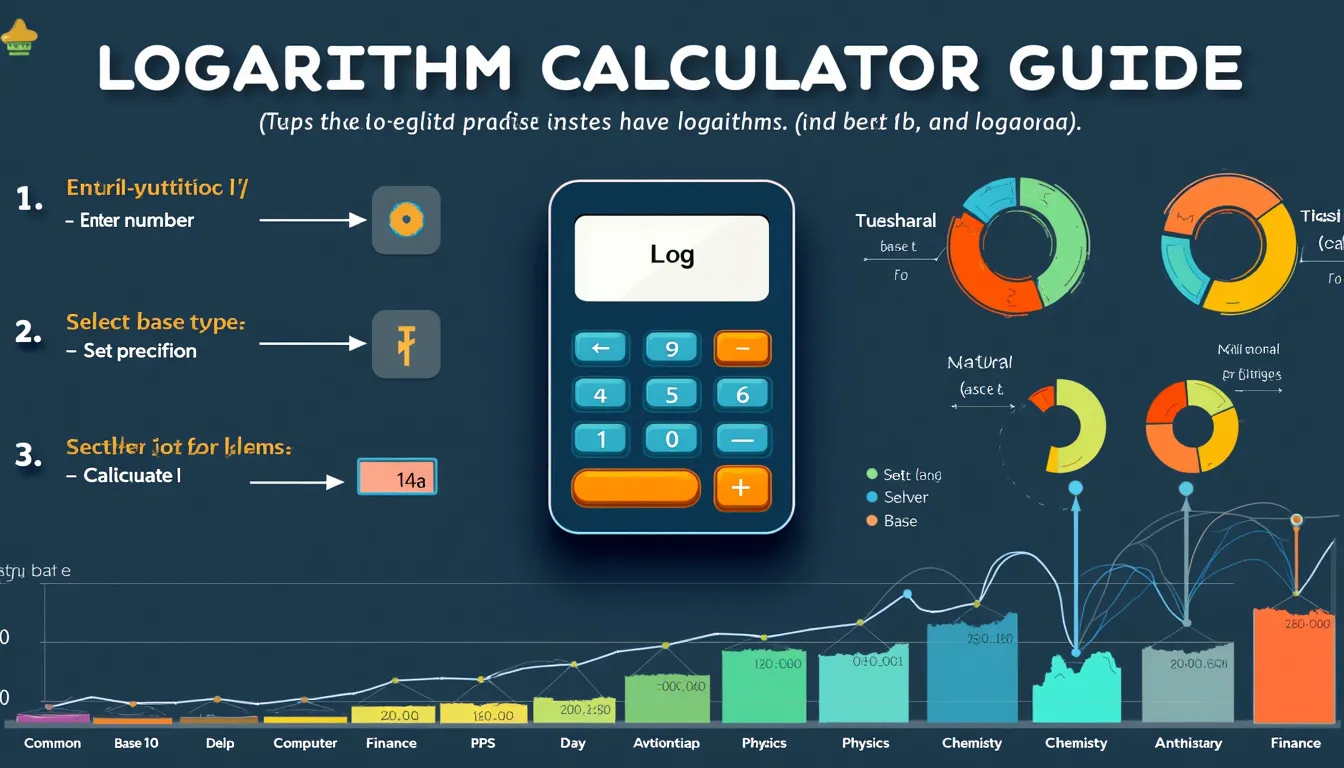Is this tool helpful?
How to Use the Logarithm Calculator Effectively
Our Logarithm Calculator is designed to simplify complex logarithmic calculations, making it an invaluable tool for students, educators, and professionals alike. Here’s a step-by-step guide on how to use this powerful calculator effectively:
1. Enter the Number
In the “Number” field, input the positive real number for which you want to calculate the logarithm. For example, you might enter 100, 2.718, or 1000000.
2. Select the Base Type
Choose the appropriate base for your logarithm calculation from the dropdown menu:
- Common Logarithm (Base 10): This is the default option and is widely used in scientific notation and many practical applications.
- Natural Logarithm (Base e): This option uses Euler’s number (approximately 2.71828) as the base, which is fundamental in calculus and many natural phenomena.
- Custom Base: Select this option if you need to calculate a logarithm with a specific base other than 10 or e.
3. Enter Custom Base (if applicable)
If you’ve selected “Custom Base,” an additional input field will appear. Enter your desired base here. Remember, the base must be a positive number not equal to 1. For instance, you might enter 2 for binary logarithms or 5 for logarithms base 5.
4. Set Precision (Optional)
You can specify the number of decimal places for the result in the “Precision” field. The default is set to 6 decimal places, but you can adjust this between 0 and 20 based on your needs. For example, entering 4 will display the result to four decimal places.
5. Calculate
Click the “Calculate” button to process your inputs. The calculator will quickly compute the result and display it below.
6. Interpret the Results
The calculator will provide two key pieces of information:
- The logarithm value: This is the primary result of your calculation.
- Exponential form: This shows the relationship between the base, the logarithm, and the original number, helping you understand the calculation in terms of exponents.
Understanding Logarithms: Definition, Purpose, and Benefits
Logarithms are powerful mathematical tools that have been simplifying complex calculations for centuries. At its core, a logarithm is the inverse operation to exponentiation. It answers the question: “To what power must a given base be raised to produce a specific number?”
Mathematical Definition
The logarithm of a positive real number x with respect to base b is the exponent to which b must be raised to yield x. Mathematically, this is expressed as:
Where:
- x is the argument or number
- b is the base of the logarithm
- y is the resulting logarithm value
Purpose of Logarithms
Logarithms serve several crucial purposes in mathematics and various scientific fields:
- Simplifying Calculations: Logarithms can transform complex multiplication and division operations into simpler addition and subtraction.
- Expressing Large Numbers: They provide a compact way to represent extremely large or small numbers, which is particularly useful in scientific notation.
- Solving Exponential Equations: Logarithms are instrumental in solving equations where the unknown appears as an exponent.
- Modeling Natural Phenomena: Many natural and economic processes follow logarithmic or exponential patterns, making logarithms essential in their study and prediction.
- Signal Processing: In fields like acoustics and image processing, logarithmic scales are used to represent data in a more perceptually relevant manner.
Benefits of Using Logarithms
The use of logarithms offers numerous benefits across various disciplines:
- Computational Efficiency: By converting multiplication to addition and division to subtraction, logarithms significantly reduce the complexity of certain calculations.
- Scale Compression: Logarithmic scales can represent a wide range of values in a compact form, making it easier to visualize and analyze data spanning several orders of magnitude.
- Pattern Recognition: In fields like data science and economics, logarithmic transformations can reveal patterns and relationships in data that might not be apparent in linear scales.
- Problem Solving: Many complex problems, especially those involving exponential growth or decay, become more manageable when approached using logarithms.
- Interdisciplinary Applications: From calculating compound interest in finance to measuring earthquake intensity in geology, logarithms have wide-ranging practical applications.
How Our Logarithm Calculator Addresses User Needs
Our Logarithm Calculator is designed to address a variety of user needs, making logarithmic calculations accessible, accurate, and efficient. Here’s how it solves specific problems:
1. Simplifying Complex Calculations
Manual logarithm calculations can be time-consuming and error-prone, especially when dealing with non-integer bases or high-precision requirements. Our calculator automates this process, providing instant and accurate results.
Example Calculation:
Let’s calculate log₃(27) manually and compare it with the calculator’s output:
Manually: We know that 3³ = 27, so log₃(27) = 3
Using the calculator:
- Enter 27 in the “Number” field
- Select “Custom Base” and enter 3
- Set precision to 6 decimal places
- Result: 3.000000
The calculator confirms our manual calculation and provides additional precision if needed.
2. Handling Various Logarithm Bases
Different fields often require calculations with specific logarithm bases. Our calculator supports common logarithms (base 10), natural logarithms (base e), and custom bases, catering to diverse user needs.
Example Calculation:
Let’s calculate log₂(1024) and compare it with log₁₀(1024):
For log₂(1024):
- Enter 1024 in the “Number” field
- Select “Custom Base” and enter 2
- Result: 10.000000
For log₁₀(1024):
- Enter 1024 in the “Number” field
- Select “Common Logarithm (Base 10)”
- Result: 3.010300
This comparison illustrates how the choice of base affects the logarithm value, with our calculator handling both cases effortlessly.
3. High-Precision Calculations
For applications requiring high precision, our calculator allows users to specify up to 20 decimal places, ensuring accuracy in advanced scientific or engineering calculations.
Example Calculation:
Let’s calculate ln(e) (which should equal 1) to 15 decimal places:
- Enter 2.718281828459045 (a more precise value of e) in the “Number” field
- Select “Natural Logarithm (Base e)”
- Set precision to 15 decimal places
- Result: 1.000000000000000
This high-precision calculation demonstrates the calculator’s capability in handling complex mathematical constants accurately.
4. Educational Tool
By providing both the logarithm value and its exponential form, our calculator serves as an excellent educational tool, helping students understand the relationship between logarithms and exponents.
Example Calculation:
Let’s use the calculator to understand the relationship between log₅(125) and 5³:
- Enter 125 in the “Number” field
- Select “Custom Base” and enter 5
- Result: 3.000000
- Exponential Form: 5³ ≈ 125
This output clearly illustrates that log₅(125) = 3 because 5³ = 125, reinforcing the concept of logarithms as inverse operations to exponentiation.
Practical Applications of the Logarithm Calculator
Our Logarithm Calculator finds applications across various fields, demonstrating its versatility and importance. Here are some practical use cases:
1. Finance and Economics
In financial calculations, logarithms are often used to determine compound interest rates or to analyze exponential growth patterns in economic models.
Example: Calculating Compound Interest
Suppose you want to know how long it will take for an investment to double at a 7% annual compound interest rate. This can be solved using the rule of 72, which is based on natural logarithms.
Time to double = 72 / Interest Rate
Time to double = 72 / 7 ≈ 10.29 years
We can verify this using our calculator:
- Enter 2 in the “Number” field (as we’re looking for the time to double)
- Select “Natural Logarithm (Base e)”
- Result: 0.693147
Now, divide this result by ln(1.07) to get the time:
- Enter 1.07 in the “Number” field
- Select “Natural Logarithm (Base e)”
- Result: 0.067658
0.693147 / 0.067658 ≈ 10.25 years, confirming our rule of 72 approximation.
2. Computer Science and Information Theory
Logarithms, especially base 2, are fundamental in computing, used in algorithms, data compression, and information theory.
Example: Calculating Bits Required for Data Representation
To determine how many bits are needed to represent 1000 distinct values:
- Enter 1000 in the “Number” field
- Select “Custom Base” and enter 2
- Result: 9.965784
This tells us that 10 bits are needed (rounding up to the nearest integer), as 2¹⁰ = 1024, which is the smallest power of 2 greater than 1000.
3. Physics and Engineering
Logarithms are used extensively in physics and engineering, particularly in dealing with scales of measurement.
Example: Calculating Decibels
To convert a sound intensity ratio to decibels, we use the formula: dB = 10 * log₁₀(I/I₀)
If a sound is 1000 times more intense than the reference level:
- Enter 1000 in the “Number” field
- Select “Common Logarithm (Base 10)”
- Result: 3.000000
Multiply this by 10 to get 30 dB, which is the sound intensity level.
4. Chemistry
In chemistry, logarithms are crucial for calculating pH levels and understanding reaction kinetics.
Example: Calculating pH
To find the pH of a solution with a hydrogen ion concentration [H⁺] of 1.0 × 10⁻⁵ mol/L:
pH = -log₁₀[H⁺]
- Enter 0.00001 (1.0 × 10⁻⁵) in the “Number” field
- Select “Common Logarithm (Base 10)”
- Result: -5.000000
The pH is the negative of this value, so the pH of the solution is 5.000000.
5. Biology and Population Studies
Logarithms are used in modeling population growth and analyzing biological processes that follow exponential patterns.
Example: Bacterial Growth
If a bacterial population doubles every 20 minutes, to calculate how many times it will double in 2 hours:
Number of doublings = Time / Doubling Time = 120 minutes / 20 minutes = 6
To find the total increase in population:
- Enter 2 in the “Number” field
- Select “Custom Base” and enter 6
- Result: 64.000000
This means the population will increase by a factor of 64 in 2 hours.
Frequently Asked Questions (FAQ)
Q1: What is the difference between natural logarithms and common logarithms?
A1: Natural logarithms (ln) use the mathematical constant e (approximately 2.71828) as the base, while common logarithms (log) use base 10. Natural logarithms are often used in calculus and natural sciences, while common logarithms are frequently used in engineering and for representing large numbers.
Q2: Can I calculate logarithms of negative numbers using this calculator?
A2: No, logarithms are only defined for positive real numbers. If you enter a negative number, the calculator will display an error message.
Q3: How do I calculate the inverse of a logarithm (antilogarithm)?
A3: To find the antilogarithm, you need to raise the base to the power of the logarithm value. For example, if log₁₀(x) = 2, then x = 10². Our calculator shows this relationship in the “Exponential Form” output.
Q4: What is the practical significance of the natural logarithm (ln)?
A4: Natural logarithms are particularly useful in calculus and differential equations because their derivative is simply 1/x. They’re also used extensively in modeling natural phenomena like population growth, radioactive decay, and compound interest.
Q5: How can I use this calculator for solving exponential equations?
A5: To solve an exponential equation like 2ˣ = 8, you can rewrite it as a logarithmic equation: log₂(8) = x. Then use the calculator with 8 as the number and 2 as the custom base to find x.
Q6: What is the relationship between logarithms and the slide rule?
A6: Slide rules, which were widely used before electronic calculators, are based on logarithmic scales. They use the principle that adding logarithms is equivalent to multiplying numbers, allowing complex calculations to be performed quickly through simple addition and subtraction on logarithmic scales.
Q7: How does changing the base affect the logarithm value?
A7: Changing the base will change the logarithm value, but the relationship between different bases can be expressed using the change of base formula: log_a(x) = log_b(x) / log_b(a). This calculator allows you to easily compare logarithms with different bases for the same number.
Q8: Can this calculator be used for logarithmic regression?
A8: While this calculator doesn’t perform regression analysis directly, it can be a helpful tool in logarithmic regression calculations. You can use it to compute individual logarithmic values that you might need during the regression process.
Q9: How are logarithms used in music theory?
A9: In music theory, logarithms are used to describe the relationship between frequencies of musical notes. The octave scale is logarithmic, with each octave representing a doubling of frequency. This calculator can help in understanding these relationships by computing logarithms base 2 of frequency ratios.
Q10: What is the significance of the number e in natural logarithms?
A10: The number e (approximately 2.71828) is a fundamental mathematical constant. It’s the base of natural logarithms and appears naturally in descriptions of growth and decay processes. Using e as the base of logarithms simplifies many calculus operations, making it invaluable in advanced mathematics and sciences.
Important Disclaimer
The calculations, results, and content provided by our tools are not guaranteed to be accurate, complete, or reliable. Users are responsible for verifying and interpreting the results. Our content and tools may contain errors, biases, or inconsistencies. We reserve the right to save inputs and outputs from our tools for the purposes of error debugging, bias identification, and performance improvement. External companies providing AI models used in our tools may also save and process data in accordance with their own policies. By using our tools, you consent to this data collection and processing. We reserve the right to limit the usage of our tools based on current usability factors. By using our tools, you acknowledge that you have read, understood, and agreed to this disclaimer. You accept the inherent risks and limitations associated with the use of our tools and services.







